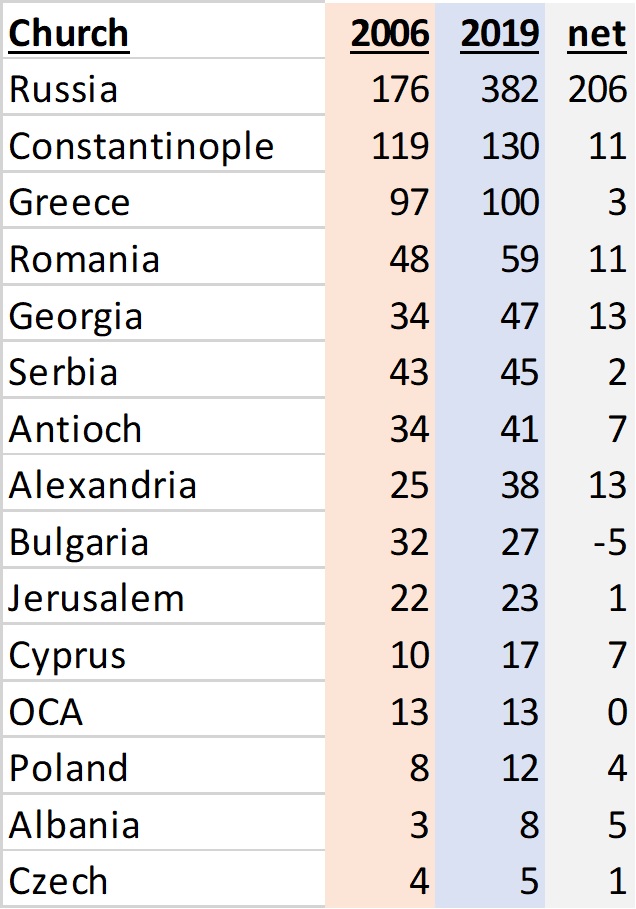In 2006, there were 668 active, canonical Orthodox bishops in the world. Today, there are 947. That’s a net increase of 279 bishops, or 42% — and most of that growth is coming from the Moscow Patriarchate.
Last week, I published an article estimating the number of Orthodox bishops in the world. (I’ve received updated info for a couple of the Churches, so my estimate has gone up slightly, from 941 to 947.) At this moment, the Russian Orthodox Church — which includes the autonomous Ukrainian Orthodox Church and ROCOR — has roughly 40% of all the bishops in the world.
But it wasn’t always that way. In 2006, the Russian Church had 26% of the world’s bishops — still the largest percentage, but nowhere close to the present day. This table shows the estimated number of bishops for each autocephalous Church in 2006 and 2019, as well as the net change over the past 13 years:
From 2006 to 2019, the Russian Orthodox Church had a net gain of +206 bishops — an increase of 117% over what was already by far the largest number of bishops in the world. The combined increase for the rest of Orthodoxy was +73 bishops, or +15%. For some context — the United States has an estimated 24% of the world’s GDP. This would be sort of like the rest of the world experiencing a 15% increase in GDP over the next 13 years, while the USA doubles its GDP.
And yet, despite this enormous increase in bishops, the Russian Church continues to have by far the highest ratio of people per bishop, roughly 435,000 to one. So you could argue that they’re just trying to catch up to their population; in fact, they could add another 200 hierarchs and their people-per-bishop ratio would still be higher than the global Orthodox average.
Orthodoxy’s 947 bishops pales in comparison to the Roman Catholic Church, which reported 5,353 bishops in 2018. That’s for an estimated global Roman Catholic population of 1.2 billion, which works out to roughly 224,000 people per bishop — virtually identical to the Orthodox ratio of 234,000 to one.
The table above tells other stories, as well. The Patriarchate of Alexandria has seen a 52% increase in the number of active bishops, which reflects the continued growth of Orthodoxy in Africa. The Patriarchates of Georgia and Romania have also shown significant growth in the number of bishops. Both are centered in formerly communist countries that now have strong Orthodox populations that routinely rank near the top of surveys of religiosity among European countries. And we’ve seen notable growth in the episcopates of smaller churches such as Cyprus, Albania, and Poland. Only Bulgaria has fewer bishops today than in 2006.
But the big story is the Church of Russia. If the rates of the past 13 years continue — big “if,” I realize — by 2037, there will be more bishops in the Russian Church than in the rest of Orthodoxy combined. That probably won’t happen, but the changes that have already taken place in recent years have changed the face of the Orthodox episcopate worldwide.
A note on my sources: For the 2006 data, I relied upon the 2006 edition of the Orthodoxia directory of bishops. The Orthodoxia directory is now available online, and it remains a valuable resource. I didn’t use it for 2019 data, though, because the structure of the database makes it difficult to easily distinguish between active bishops and retired or deceased bishops. For 2019, I relied primarily upon official lists published by the various autocephalous Churches online.

Not sure the size of the Russian episcopate is ideal for the church.
Note the author’s observation above: “And yet, despite this enormous increase in bishops, the Russian Church continues to have by far the highest ratio of people per bishop, roughly 435,000 to one. So you could argue that they’re just trying to catch up to their population; in fact, they could add another 200 hierarchs and their people-per-bishop ratio would still be higher than the global Orthodox average.”
And Chris’ comment below: “Glad you mentioned the ratio of bishops to faithful in your post. Including those figures (and totals for all Orthodoxy) in the table for 2006 and 2019 would go a long way to properly contextualizing the growth of the MP’s episcopacy. One might argue the MP is still recovering from Communism….”
Yes indeed! We too, here at Gubat, Sorsogon has contributed a little community. We entered Orthodoxy August of 2006. Glory to God!
this means that the slavic block – russia, romania, bulgaria, poland, czech, oca, bulgaria, georgia yields 590,,,,,,,,,,,,where as the greek block – const, cyprus, albania, greece yields 255,,,,,,,,jerusalem, alexandria and antioch not counted – thyese yield 102,,,,,,,so the slavi block is 2.3 times the greek block — it would be interewsting to see what the old calendar groups and the disputed canonicals do to this analysis — we tend to shun them, but they are not going away and become canonical/non canonical with the swipe of pen
Glad you mentioned the ratio of bishops to faithful in your post. Including those figures (and totals for all Orthodoxy) in the table for 2006 and 2019 would go a long way to properly contextualizing the growth of the MP’s episcopacy. One might argue the MP is still recovering from Communism. Not sure there are reliable numbers, but a good control for these numbers would be the 1917 numbers for as many local churches (or a total) as possible. I think we can all agree numbers of faithful are likely to be inflated, which means the real ratio of bishops to active faithful is even lower, in every Orthodox jurisdiction.